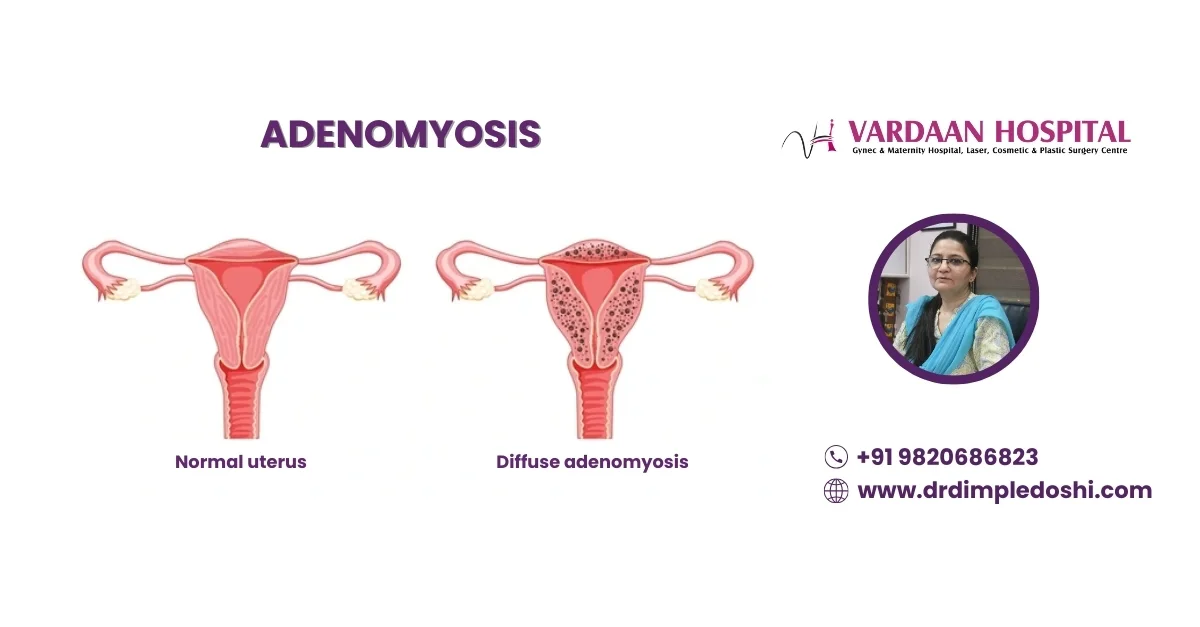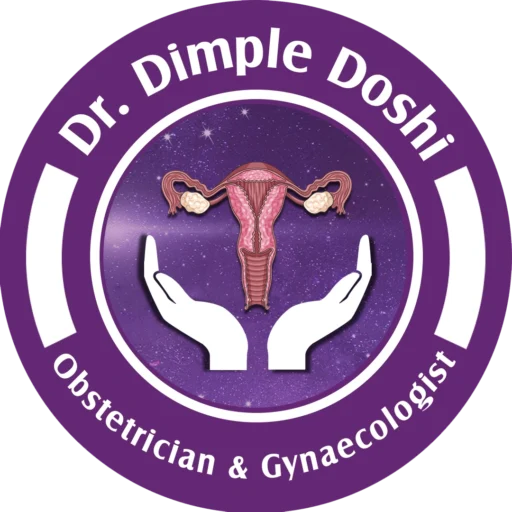Effective Adenomyosis Treatment in Goregaon West, Mumbai
 Understanding Adenomyosis of Uterus
Understanding Adenomyosis of Uterus
Adenomyosis is a uterine condition that can cause severe menstrual cramps, chronic lower abdominal pain, and heavy bleeding. If you are experiencing these symptoms, consulting a gynecologist is essential.
Key Symptoms of Adenomyosis of uterus
- Severe menstrual cramps
- Chronic lower abdominal pain
- Heavy menstrual bleeding
- Painful vaginal intercourse
- Pressure on the bladder
- Fatigue and dizziness due to excessive blood loss
Though adenomyosis is a benign (non-cancerous) condition, it can severely impact a woman’s quality of life.
Causes of Adenomyosis of uterus
Adenomyosis is more commonly diagnosed in middle-aged women and those who have had children. However, young women can also be affected. The exact cause is unknown, but some contributing factors include:
- Pregnancy
- Cesarean section
- Repeated or single abortions
- Genetic predisposition
- Hormonal imbalances (elevated estrogen, prolactin, or FSH levels)
- Prior uterine surgery
Diagnosis of Adenomyosis of uterus
Adenomyosis can be diagnosed through the following methods:
- Physical Examination: Your gynecologist will perform a pelvic exam to assess any abnormalities.
- Ultrasonography: A non-invasive imaging technique used to detect uterine abnormalities.
- MRI: Magnetic Resonance Imaging (MRI) provides detailed imaging to confirm the presence of adenomyosis.
Best Doctor for Adenomyosis of uterus Treatment in Goregaon West, Mumbai
Dr. Dimple Doshi, a highly experienced gynecologist and laparoscopic surgeon, is one of the best doctors for adenomyosis treatment in Goregaon West, Mumbai. With over 23 years of experience, Dr. Doshi specializes in minimally invasive gynecological procedures and provides personalized treatment for adenomyosis, ensuring optimal patient care and recovery.
Treatment Options for Adenomyosis of uterus
A. Conservative Treatment
Non-surgical management options include:
-
Pain Management: Medications to control pain and inflammation.
-
Bleeding Control: Drugs such as tranexamic acid to reduce heavy bleeding.
-
Hormonal Therapy: Options such as:
-
Hormonal intrauterine devices (e.g., Mirena)
-
Progesterone-based oral medications
-
B. Surgical Management
When conservative treatments are ineffective, surgical intervention may be required.i. Uterus-Sparing Surgery
-
- Adenomyomectomy– Surgical removal of the adenomyotic tissue while preserving the uterus.
- Microwave Ablation (MWA) for Adenomyosis: is an emerging minimally invasive treatment option that uses microwave energy to generate heat and destroy abnormal adenomyotic tissue while preserving the uterus.
ii. Non-Uterus Sparing Surgery (Hysterectomy)
- Recommended for women who have completed their families and no longer wish to retain the uterus.
- Complete removal of the uterus provides a permanent cure for adenomyosis.
Frequently Asked Question
Q1. Can adenomyosis be cured without surgery?
Ans. Yes, adenomyosis can be managed with non-surgical treatments like pain relievers, hormonal therapy (such as Mirena IUD or GnRH agonists), and medications to control heavy bleeding. However, in severe cases, surgery may be necessary.
Q2. Is adenomyosis the same as endometriosis?
Ans. No, adenomyosis and endometriosis are different conditions. Adenomyosis occurs when the uterine lining grows into the uterine muscle, while endometriosis happens when the uterine lining grows outside the uterus. However, both can cause severe menstrual pain and heavy bleeding.
Q3. What are the best treatment options for women who want to conceive?
Ans. For women who wish to have children, conservative treatments like hormonal therapy or uterus-sparing surgery (such as adenomyomectomy) may be recommended. A fertility specialist can guide the best approach.
Q4. How do I know if I need surgery for adenomyosis?
Ans. Surgery is usually recommended if symptoms are severe, persistent, and do not respond to medications. If fertility is not a concern, hysterectomy (removal of the uterus) may be the most effective long-term solution.
Q5. How long does recovery take after adenomyosis surgery?
Ans. Recovery depends on the type of surgery. Minimally invasive procedures like laparoscopic adenomyomectomy or microwave ablation may require 1-2 weeks, while hysterectomy may take 4-6 weeks for complete recovery.
Medical Code for Adenomyosis of uterus
ICD-10 and CPT Codes for Adenomyosis Treatment
ICD-10 Codes for Adenomyosis
- N80.0: Endometriosis of the uterus (often used for adenomyosis)
- N80.A: Specific code for adenomyosis
- N80.8 & N80.9: Other and unspecified endometriosis
CPT Codes for Surgical Treatment
- 58150: Total abdominal hysterectomy
- 58570-58575: Laparoscopic hysterectomy procedures
- 58356: Endometrial ablation
- 58662: Laparoscopic excision of pelvic lesions
Consult Dr. Dimple Doshi – Leading Adenomyosis Specialist in Goregaon West, Mumbai
If you are suffering from persistent pelvic pain, heavy bleeding, or any of the symptoms mentioned above, Dr. Dimple Doshi at Vardaan Hospital is your trusted expert. With advanced diagnostic techniques and personalized treatment plans, she ensures that patients receive the best possible care.
